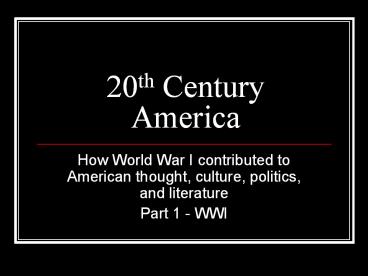20th Century America - PowerPoint PPT Presentation
1 / 11
Title:
20th Century America
Description:
Grenades were essential to trench warfare in World War I and date back in some form to the 15th century. Grenades are still in use today in modern combat. – PowerPoint PPT presentation
Number of Views:209
Avg rating:3.0/5.0
Title: 20th Century America
1
20th Century America
- How World War I contributed to American thought,
culture, politics, and literature - Part 1 - WWI
2
About WWI
- Causes of WWI, pt. 1
- Treaty Alliance System Political maneuvers
sought encirclement and protection from the
imperialistic aspirations of neighboring nations.
The assassination of Archduke Franz Ferdinand
encouraged domino-effect declarations of war by
nations across first Europe and then the world. - Imperialism Many nations sought to increase
their territory and national wealth. Britain and
Frances colonial acquisitions prompted Germany
to scramble into forging colonies in Africa.
3
About WWI
- Causes of WWI, pt. 2
- Militarism Ruling entities in Britain, France,
and Germany engaged in an arms race as military
exploits were seen as a central focus for each
government. Invasion plans and strategies were
drawn up by many governments. - Nationalism Many nations desired independence
from ruling authorities, particularly Serbia and
other Balkan principalities from Austria-Hungary.
Others, including the Italians and Germans,
desired unification after being left as separate
states at the conclusion of the Congress of
Vienna.
4
Weapons of War
- Bayonet - a blade that is attached to the barrel
of a rifle for use in close combat - The bayonet, an outdated weapon in offensive
warfare, was seen as symbolic of a warrior
mentality. Bayonets continued to be issued to
personnel in the Second World War.
5
Weapons of War
- Flamethrower spreads fire by launching fuel
- Initially used by the Germans in short range
trench warfare against the British and French,
flamethrowers were later adopted by both the
British and French armies. Not effective at
distance or in covering large areas, the
flamethrower was a short-range trench-clearer.
6
Weapons of War
- Grenade an explosive, either hand or
rifle-driven with detonation triggered by either
impact or a timer. - Grenades were essential to trench warfare in
World War I and date back in some form to the
15th century. Grenades are still in use today in
modern combat.
7
Weapons of War
- Machine Gun often tripod-mounted, the gun
produced a rapid-fire succession of bullets
(estimated between 400 rounds/min in 1914 and up
to 1200 rounds/min by the end of the war) - Machine guns were typically used to maintain
defensive positions. In this era, the machine gun
was too heavy to be portable, and thus was not
often used as an offensive weapon.
8
Weapons of War
- Trench mortars a short tube that fires a
projectile (explosive) at a steep angle so that
it falls directly on an enemy. - Trench mortars could be fired from the relative
safety of inside the trench.
9
Weapons of War
- Tank an armored car driven on a caterpillar
track, often with mounted machine guns, later
with large artillery guns - Tanks didnt figure into WWI until 1916, but by
the end of the war were an important means to
cross trenches and advance infantry in a more
protected manner. The British and French built
over 7000 tanks combined. Germany, having not
foreseen the tanks potential, only produced 20.
10
Weapons of War
- Poison Gas a variety of airborne chemicals,
sometimes released from canisters, sometimes by
means of artillery shell. - Poison Gas tear gas, mustard gas, chlorine,
etc. had a variety of effects. Some effects
were deadly, all were unpleasant. Poison gas
attacks were used in anti-German propaganda
(though the French were the first to use gas
attacks in 1914). Walls of gas could be used to
disable or clear trench areas.
11
Weapons of War
- Rifles, Pistols, etc.
- The General Change in Philosophy Although war
has always involved some amount of killing, the
Great War brought about a philosophical shift.
No longer would battles be carried out primarily
in a man-against-man or man-against-fortress
fashion. The means of bringing about an enemys
death expeditiously was at a premium, especially
when it involved a minimal human cost from ones
own ranks.































